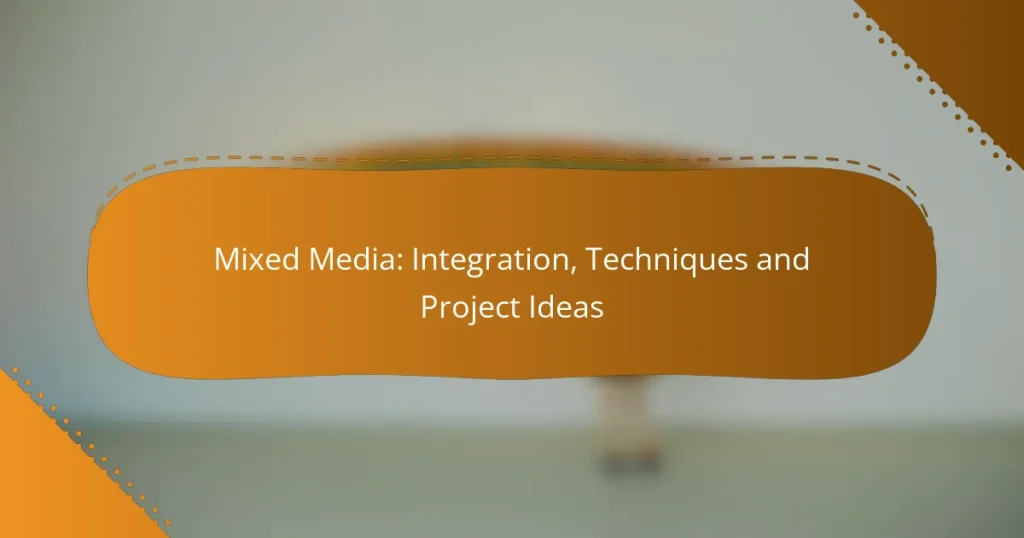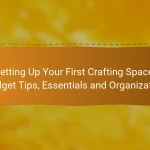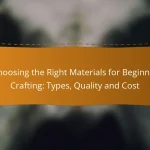Mixed media art offers a dynamic approach to creativity by integrating various artistic techniques and materials, resulting in unique and engaging works. By blending traditional and contemporary forms, artists can enhance their visual storytelling and emotional resonance. Exploring popular project ideas, such as journals and multimedia installations, encourages innovation and experimentation in the artistic process.
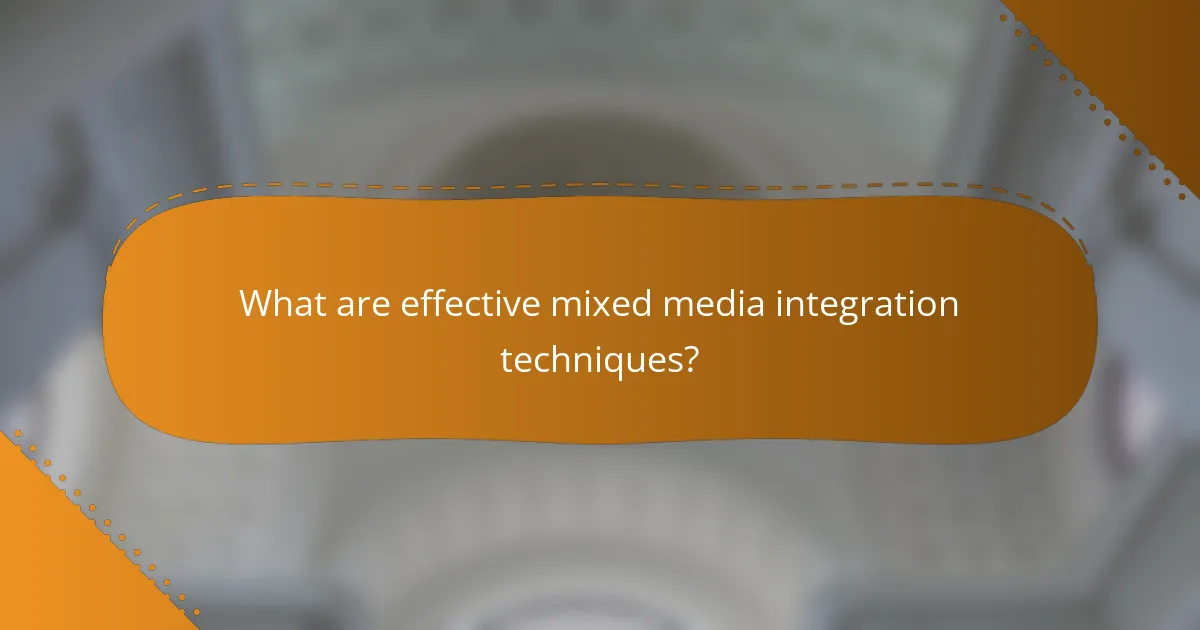
What are effective mixed media integration techniques?
Effective mixed media integration techniques combine various artistic methods to create unique and engaging works. These techniques allow artists to blend traditional and contemporary forms, enhancing visual storytelling and emotional impact.
Layering traditional and digital media
Layering traditional and digital media involves combining physical art forms, like painting or drawing, with digital elements, such as graphic design or digital painting. This technique allows for depth and texture that can be difficult to achieve with either medium alone.
To successfully layer these media, start by creating a base with traditional materials, then scan or photograph your work to manipulate it digitally. Consider using software like Adobe Photoshop or Procreate to add digital layers, adjusting opacity and blending modes for a cohesive look.
Combining painting with photography
Combining painting with photography creates a striking contrast between realism and abstraction. Artists can enhance photographs with painted elements, adding color, texture, or even entirely new subjects to the image.
Begin by selecting a strong photographic base, then use acrylics or watercolors to paint over specific areas. This technique can highlight emotions or themes in the photograph, making it more personal and expressive. Be mindful of balance; too much paint can overwhelm the original image.
Using collage and digital editing
Using collage and digital editing allows artists to assemble various materials, such as paper, fabric, and digital images, into a cohesive artwork. This method encourages creativity and experimentation with textures and forms.
Start by gathering materials and arranging them physically or digitally. Use software to enhance the collage, adjusting colors and adding effects to unify the composition. Ensure that the elements work together harmoniously, avoiding clutter that can distract from the main theme.
Incorporating sound and video elements
Incorporating sound and video elements into mixed media projects adds a dynamic layer that engages multiple senses. This technique can transform a static piece into an immersive experience, drawing viewers deeper into the artwork.
Consider using audio clips or video projections alongside traditional media. For example, a painting could be accompanied by a soundscape that reflects its mood. When integrating these elements, ensure that the audio and visual components complement each other, enhancing rather than competing for attention.

What are popular mixed media project ideas?
Popular mixed media project ideas include creating journals, multimedia installations, sculptures, and community art projects. These projects allow artists to combine various materials and techniques, fostering creativity and innovation.
Creating a mixed media journal
Creating a mixed media journal involves combining different materials such as paper, fabric, paint, and found objects to express personal thoughts and emotions. Start by selecting a sturdy journal and gather supplies that inspire you, including stickers, stamps, and collage materials.
Consider dedicating each page to a theme or emotion, allowing for exploration and experimentation. Use techniques like layering, painting, and collage to enhance visual interest and depth.
Designing a multimedia installation
Designing a multimedia installation requires integrating various art forms, such as video, sound, and physical objects, to create an immersive experience. Begin by conceptualizing a theme that resonates with your audience and select materials that complement your vision.
Plan the layout carefully, considering how viewers will interact with the installation. Use lighting and sound strategically to enhance the atmosphere and engage the senses, ensuring a cohesive experience.
Making a mixed media sculpture
Making a mixed media sculpture involves combining materials like clay, metal, wood, and recycled items to create three-dimensional art. Start with a strong base and build upon it using different textures and forms to add complexity.
Experiment with techniques such as assemblage or casting, and consider how each material contributes to the overall message of the piece. Ensure that your sculpture is stable and can withstand handling if displayed publicly.
Developing a community art project
Developing a community art project brings together local artists and residents to create a shared piece of art that reflects the community’s identity. Start by organizing meetings to gather input and ideas from participants, ensuring everyone feels included.
Choose a location and medium that resonates with the community, such as a mural or a collaborative sculpture. Set clear goals and timelines, and encourage ongoing participation to foster a sense of ownership and pride in the final artwork.
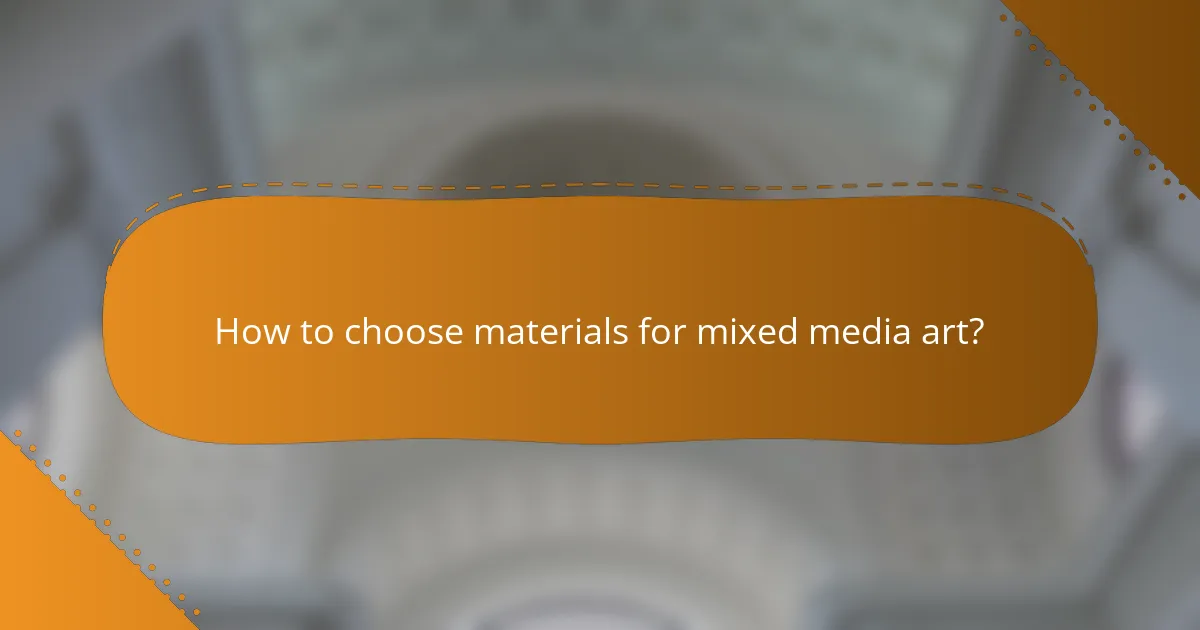
How to choose materials for mixed media art?
Selecting materials for mixed media art involves understanding how different elements interact and complement each other. Consider the properties of each material, such as texture, adhesion, and drying time, to create cohesive and visually appealing pieces.
Understanding compatibility of materials
Compatibility of materials is crucial in mixed media art to ensure that they adhere properly and do not react negatively with each other. For example, using oil-based paints with water-based mediums can lead to issues like peeling or cracking. Always test materials together on a small scale before committing to a larger project.
Consider the drying times and textures of your chosen materials. For instance, combining heavy textures like modeling paste with lighter materials can create interesting contrasts, but be mindful of how they will bond as they dry.
Exploring sustainable art supplies
Sustainable art supplies are increasingly available and can enhance your mixed media projects while being environmentally friendly. Look for products made from recycled materials, non-toxic pigments, and biodegradable adhesives. Brands often label their products as eco-friendly, making it easier to identify suitable options.
Incorporating natural materials like leaves, stones, or reclaimed wood not only adds unique textures but also promotes sustainability. These materials can often be sourced locally, reducing your environmental footprint.
Evaluating cost-effective options
Cost-effective options for mixed media art can help you stay within budget while exploring your creativity. Consider purchasing materials in bulk or from discount art supply stores to save money. Online marketplaces often offer competitive prices for a wide range of supplies.
Additionally, repurposing items from around your home, such as old magazines, fabric scraps, or packaging materials, can provide unique elements for your artwork without incurring extra costs. This approach not only saves money but also encourages innovative thinking in your projects.
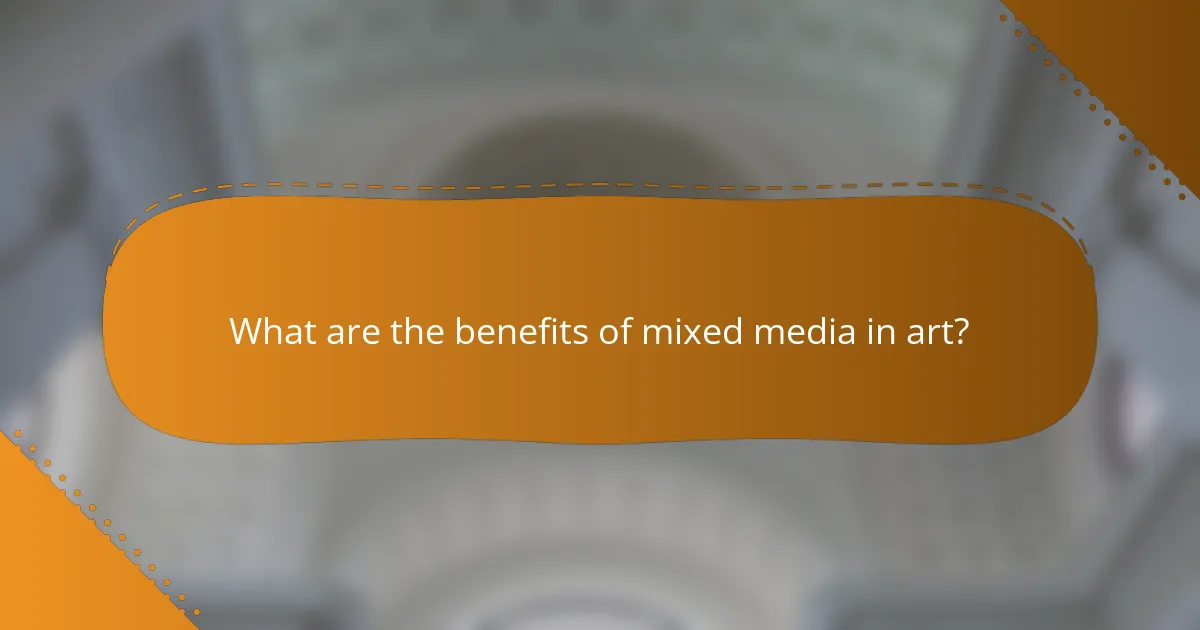
What are the benefits of mixed media in art?
Mixed media in art offers diverse advantages, including enhanced creativity, increased engagement, and the freedom to experiment with various techniques. By combining different materials and methods, artists can create unique expressions that resonate more deeply with their audience.
Enhances creative expression
Mixed media allows artists to break free from traditional boundaries, fostering a broader range of creative expression. By integrating various materials such as paint, paper, fabric, and found objects, artists can convey complex emotions and ideas that a single medium might not capture.
For example, an artist might combine acrylic paint with collage elements to create a textured, layered effect that adds depth to their work. This approach not only enriches the visual experience but also invites viewers to explore multiple interpretations.
Encourages experimentation
The use of mixed media encourages artists to experiment with different techniques and materials, leading to innovative outcomes. This experimentation can help artists discover new styles and methods that enhance their overall artistic practice.
Artists can try combining unconventional items, such as incorporating digital prints with traditional painting. This blend can result in unexpected textures and visual narratives, pushing the boundaries of their creativity.
Increases audience engagement
Mixed media art often captivates audiences more effectively than traditional forms due to its dynamic nature. The varied textures, colors, and materials can draw viewers in, prompting them to spend more time interacting with the artwork.
For instance, a piece that includes both painting and three-dimensional elements may invite viewers to touch or closely examine the work, creating a more immersive experience. This heightened engagement can lead to deeper emotional connections and discussions about the art.

What tools and platforms can assist in mixed media projects?
Several tools and platforms can enhance mixed media projects by providing versatile features for digital editing, illustration, and design. Utilizing the right software can streamline your creative process and expand your artistic capabilities.
Adobe Creative Suite for digital editing
Adobe Creative Suite is a comprehensive collection of software that includes Photoshop, Illustrator, and InDesign, making it ideal for digital editing in mixed media projects. Photoshop excels in photo manipulation and raster graphics, while Illustrator is perfect for vector illustrations, and InDesign is great for layout design.
When using Adobe Creative Suite, consider subscription costs, which can range from around $20 to $50 per month depending on the plan. Familiarity with the software can significantly enhance your workflow, so take advantage of tutorials and community forums to improve your skills.
Procreate for digital illustration
Procreate is a powerful digital illustration app available on iPad, favored for its intuitive interface and extensive brush library. It allows artists to create detailed illustrations and offers features like layering and blending modes, which are essential for mixed media work.
With a one-time purchase price of about $10, Procreate is a cost-effective option for illustrators. To maximize its potential, explore the app’s advanced features, such as custom brushes and animation tools, which can add depth to your projects.
Canva for design and layout
Canva is an accessible online platform that simplifies design and layout creation, making it suitable for mixed media projects. It offers a wide range of templates and design elements, allowing users to create visually appealing graphics without extensive design experience.
Canva operates on a freemium model, with basic features available for free and premium options starting at around $12.95 per month. To effectively use Canva, focus on understanding its drag-and-drop functionality and explore its extensive library of stock images and fonts to enhance your designs.
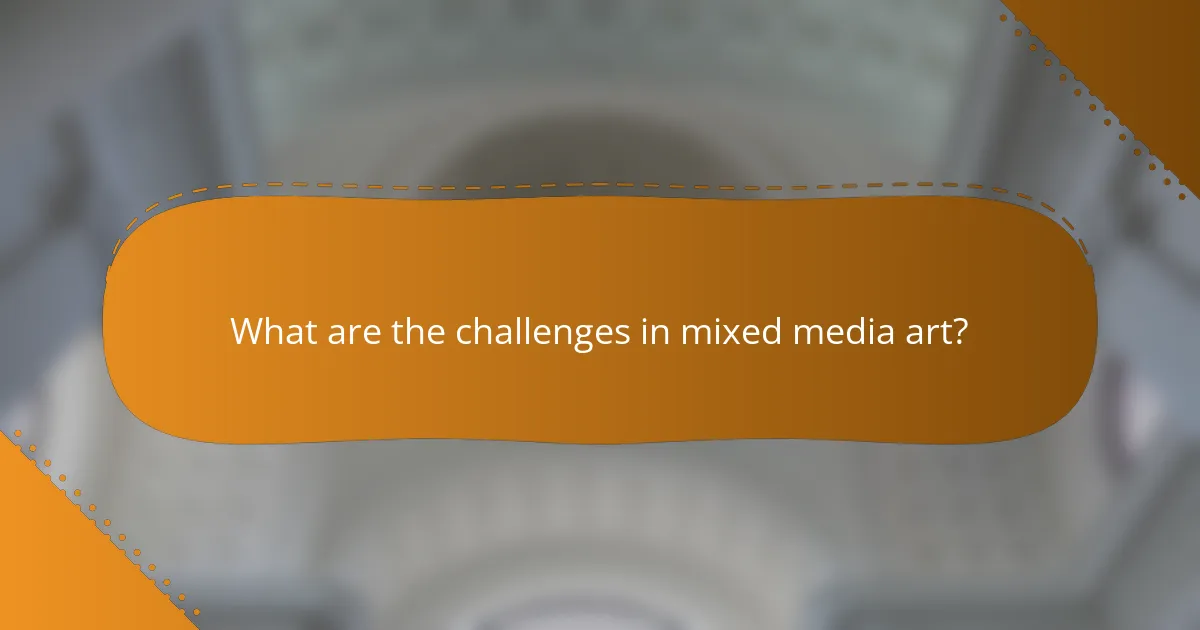
What are the challenges in mixed media art?
Mixed media art presents several challenges, including the integration of different materials, managing drying times, and ensuring durability. Artists must navigate the complexity of combining various techniques while maintaining a cohesive vision.
Material Compatibility
One of the primary challenges in mixed media art is ensuring that different materials work well together. For instance, combining water-based and oil-based products can lead to adhesion issues. Artists should test materials on a small scale before applying them to larger works to avoid unexpected reactions.
Drying Times and Layering
Managing drying times is crucial when working with mixed media. Some materials dry quickly, while others take longer, which can complicate layering techniques. Artists should plan their workflow to accommodate these differences, allowing sufficient time for each layer to dry before adding new elements.
Durability and Preservation
Ensuring the durability of mixed media artworks can be challenging due to the use of diverse materials. Some components may degrade faster than others, affecting the overall piece. Using appropriate sealants and protective coatings can help preserve the integrity of the artwork over time.
Balancing Composition
Achieving a balanced composition in mixed media can be difficult, as the visual weight of different materials varies. Artists should consider the placement and proportion of each element to create harmony. Utilizing a sketch or digital mock-up can assist in visualizing the final piece before execution.
